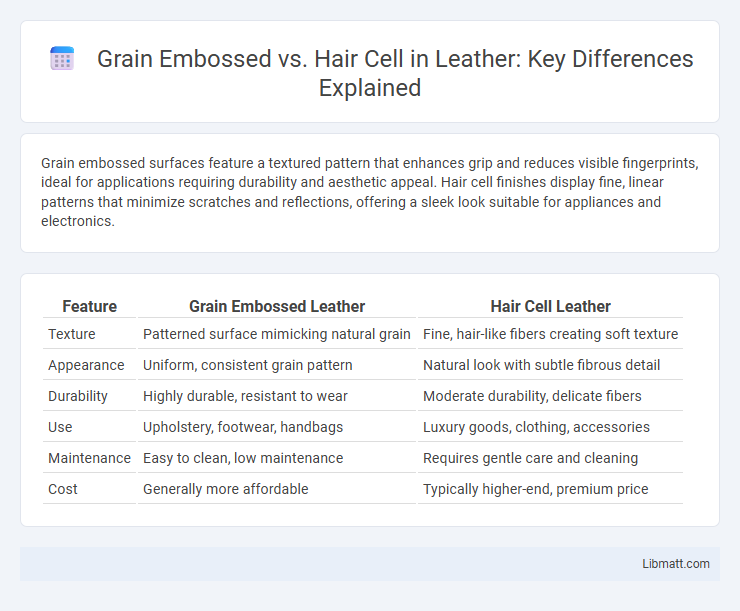Grain embossed surfaces feature a textured pattern that enhances grip and reduces visible fingerprints, ideal for applications requiring durability and aesthetic appeal. Hair cell finishes display fine, linear patterns that minimize scratches and reflections, offering a sleek look suitable for appliances and electronics.
Table of Comparison
| Feature | Grain Embossed Leather | Hair Cell Leather |
|---|---|---|
| Texture | Patterned surface mimicking natural grain | Fine, hair-like fibers creating soft texture |
| Appearance | Uniform, consistent grain pattern | Natural look with subtle fibrous detail |
| Durability | Highly durable, resistant to wear | Moderate durability, delicate fibers |
| Use | Upholstery, footwear, handbags | Luxury goods, clothing, accessories |
| Maintenance | Easy to clean, low maintenance | Requires gentle care and cleaning |
| Cost | Generally more affordable | Typically higher-end, premium price |
Introduction to Grain Embossed and Hair Cell Textures
Grain embossed and hair cell textures are commonly used finishes in metal surfaces to enhance durability and aesthetic appeal. Grain embossed textures feature a random pattern of fine, wave-like impressions that help to mask fingerprints and minor scratches, making them ideal for high-traffic areas. Hair cell textures consist of parallel, brushed lines that create a sleek, linear appearance, often used in elevators, appliances, and architectural panels for a modern, refined look.
Defining Grain Embossed and Hair Cell Finishes
Grain embossed and hair cell finishes refer to textured surface treatments commonly applied to metals and laminates, enhancing aesthetic appeal and durability. Grain embossed finishes feature a pronounced, patterned texture resembling natural wood grain or brushed metal, providing a tactile and visual depth ideal for design elements in cabinetry and appliances. Hair cell finishes, characterized by fine, linear scratch patterns resembling hair strands, create a subtle matte effect that reduces glare and fingerprints, making your surfaces easier to maintain in high-use environments.
Manufacturing Processes of Grain Embossed vs Hair Cell
Grain embossed surfaces are created through a rolling or pressing process that imprints a textured pattern onto metal sheets, offering enhanced grip and aesthetic appeal. Hair cell finishes involve brushing metal with fine abrasives or wire brushes to produce linear, hair-like textures that mask fingerprints and scratches effectively. Your choice depends on the desired tactile feel and visual finish, as grain embossing adds depth while hair cell provides subtle, directional patterns.
Visual Differences: Grain Embossed vs Hair Cell
Grain embossed finishes feature a textured surface with irregular, natural wood-like patterns that create a rustic, tactile appearance, while hair cell finishes display fine, linear striations that run uniformly across the surface, offering a sleek and subtle shimmer. The grain embossed texture adds depth and a rugged aesthetic, enhancing visual interest through its uneven surface, compared to the smooth, narrow lines of the hair cell finish that emphasize minimalism and modernity. Your choice between these finishes will affect how light reflects and how the surface is perceived in terms of warmth and sophistication.
Surface Performance and Durability Comparison
Grain embossed surfaces offer a textured finish that enhances scratch resistance and hides wear marks, making them ideal for high-traffic areas requiring durable materials. Hair cell finishes provide a fine linear texture that reduces glare and fingerprints but may be more susceptible to visible scratches over time. Your choice between grain embossed and hair cell should consider the balance between surface aesthetics and long-term durability needs.
Applications in Industry: Where Each Texture Excels
Grain embossed textures excel in automotive interiors and kitchen appliances due to their durability and ability to hide scratches, providing a premium feel. Hair cell finishes are preferred in elevator panels and architectural surfaces for their fine, linear patterns that reduce fingerprints and enhance aesthetic appeal. Both textures serve specific industrial needs by combining functionality with visual appeal in metal and plastic applications.
Cleaning and Maintenance Requirements
Grain embossed surfaces tend to hide dirt and fingerprints better, requiring less frequent cleaning compared to hair cell finishes, which show smudges more easily and demand regular wiping. Hair cell textures are more resistant to scratches and wear, making them easier to maintain over time with gentle cleaning agents. Your choice between grain embossed and hair cell will impact the frequency and type of maintenance needed to keep the surface looking pristine.
Aesthetic Appeal: Choosing Based on Design Needs
Grain embossed surfaces offer a textured, natural wood look that enhances rustic or traditional designs, while hair cell finishes provide a smoother, subtle matte texture suited for modern or minimalist aesthetics. Your choice between grain embossed and hair cell should align with the overall style and visual impact you want to achieve in your space. Selecting the appropriate finish ensures your project maintains cohesive aesthetic appeal and meets specific design requirements effectively.
Cost Implications of Grain Embossed and Hair Cell Finishes
Grain embossed finishes typically incur lower production costs due to simpler manufacturing processes and widespread availability of embossing machinery, making them a budget-friendly option for large-scale projects. Hair cell finishes, characterized by fine linear textures created through precise brushing or grinding techniques, often require more labor and advanced equipment, resulting in higher material and labor expenses. Choosing between grain embossed and hair cell finishes depends on balancing aesthetic preferences with budget constraints in architectural or industrial applications.
How to Select Between Grain Embossed and Hair Cell Textures
Selecting between grain embossed and hair cell textures depends on the desired aesthetic and practical application. Grain embossed offers a more pronounced, tactile surface ideal for hiding scratches and fingerprints, making it suitable for high-traffic areas or frequently handled items. Hair cell texture provides a subtle, linear pattern that enhances visual appeal and adds a refined finish, perfect for sleek appliances or modern interior elements that require a smooth yet textured look for your projects.
Grain embossed vs hair cell Infographic

 libmatt.com
libmatt.com